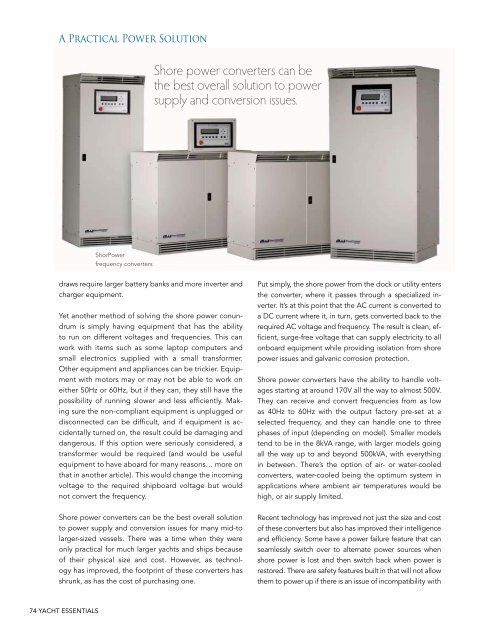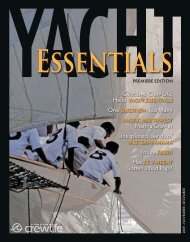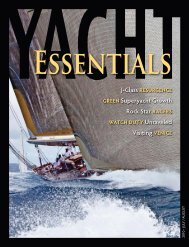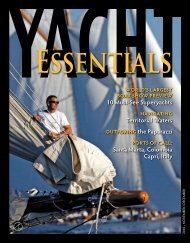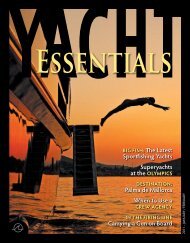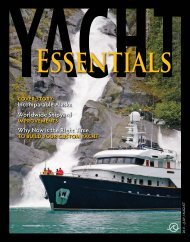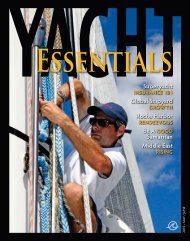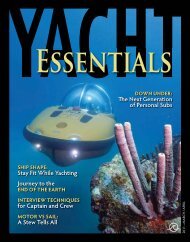photo contest - Yacht Essentials
photo contest - Yacht Essentials
photo contest - Yacht Essentials
You also want an ePaper? Increase the reach of your titles
YUMPU automatically turns print PDFs into web optimized ePapers that Google loves.
A Practical Power Solution<br />
draws require larger battery banks and more inverter and<br />
charger equipment.<br />
Yet another method of solving the shore power conundrum<br />
is simply having equipment that has the ability<br />
to run on different voltages and frequencies. This can<br />
work with items such as some laptop computers and<br />
small electronics supplied with a small transformer.<br />
Other equipment and appliances can be trickier. Equipment<br />
with motors may or may not be able to work on<br />
either 50Hz or 60Hz, but if they can, they still have the<br />
possibility of running slower and less efficiently. Making<br />
sure the non-compliant equipment is unplugged or<br />
disconnected can be difficult, and if equipment is accidentally<br />
turned on, the result could be damaging and<br />
dangerous. If this option were seriously considered, a<br />
transformer would be required (and would be useful<br />
equipment to have aboard for many reasons… more on<br />
that in another article). This would change the incoming<br />
voltage to the required shipboard voltage but would<br />
not convert the frequency.<br />
Shore power converters can be the best overall solution<br />
to power supply and conversion issues for many mid-to<br />
larger-sized vessels. There was a time when they were<br />
only practical for much larger yachts and ships because<br />
of their physical size and cost. However, as technology<br />
has improved, the footprint of these converters has<br />
shrunk, as has the cost of purchasing one.<br />
74 YACHT ESSENTIALS<br />
ShorPower<br />
frequency converters<br />
Shore power converters can be<br />
the best overall solution to power<br />
supply and conversion issues.<br />
Put simply, the shore power from the dock or utility enters<br />
the converter, where it passes through a specialized inverter.<br />
It’s at this point that the AC current is converted to<br />
a DC current where it, in turn, gets converted back to the<br />
required AC voltage and frequency. The result is clean, efficient,<br />
surge-free voltage that can supply electricity to all<br />
onboard equipment while providing isolation from shore<br />
power issues and galvanic corrosion protection.<br />
Shore power converters have the ability to handle voltages<br />
starting at around 170V all the way to almost 500V.<br />
They can receive and convert frequencies from as low<br />
as 40Hz to 60Hz with the output factory pre-set at a<br />
selected frequency, and they can handle one to three<br />
phases of input (depending on model). Smaller models<br />
tend to be in the 8kVA range, with larger models going<br />
all the way up to and beyond 500kVA, with everything<br />
in between. There’s the option of air- or water-cooled<br />
converters, water-cooled being the optimum system in<br />
applications where ambient air temperatures would be<br />
high, or air supply limited.<br />
Recent technology has improved not just the size and cost<br />
of these converters but also has improved their intelligence<br />
and efficiency. Some have a power failure feature that can<br />
seamlessly switch over to alternate power sources when<br />
shore power is lost and then switch back when power is<br />
restored. There are safety features built in that will not allow<br />
them to power up if there is an issue of incompatibility with


